Accounting Assignment: Ledger Accounts, Trial Balance, and Statements
VerifiedAdded on 2021/02/20
|21
|4204
|159
Homework Assignment
AI Summary
This accounting assignment provides a comprehensive solution to various accounting tasks. It begins with recording, balancing, and closing ledger accounts, followed by the formulation of trial balances, and the preparation of profit and loss accounts and balance sheets for different companies (Maxim, Pendo, Mafuta, and Ricardo). The assignment covers journal entries, ledger accounts, trial balances, income statements, and statements of financial position. It also includes the differentiation between revenue and capital expenditure. The solution demonstrates the complete accounting cycle, providing detailed workings and explanations for each step, making it a valuable resource for students studying accounting principles and practices.
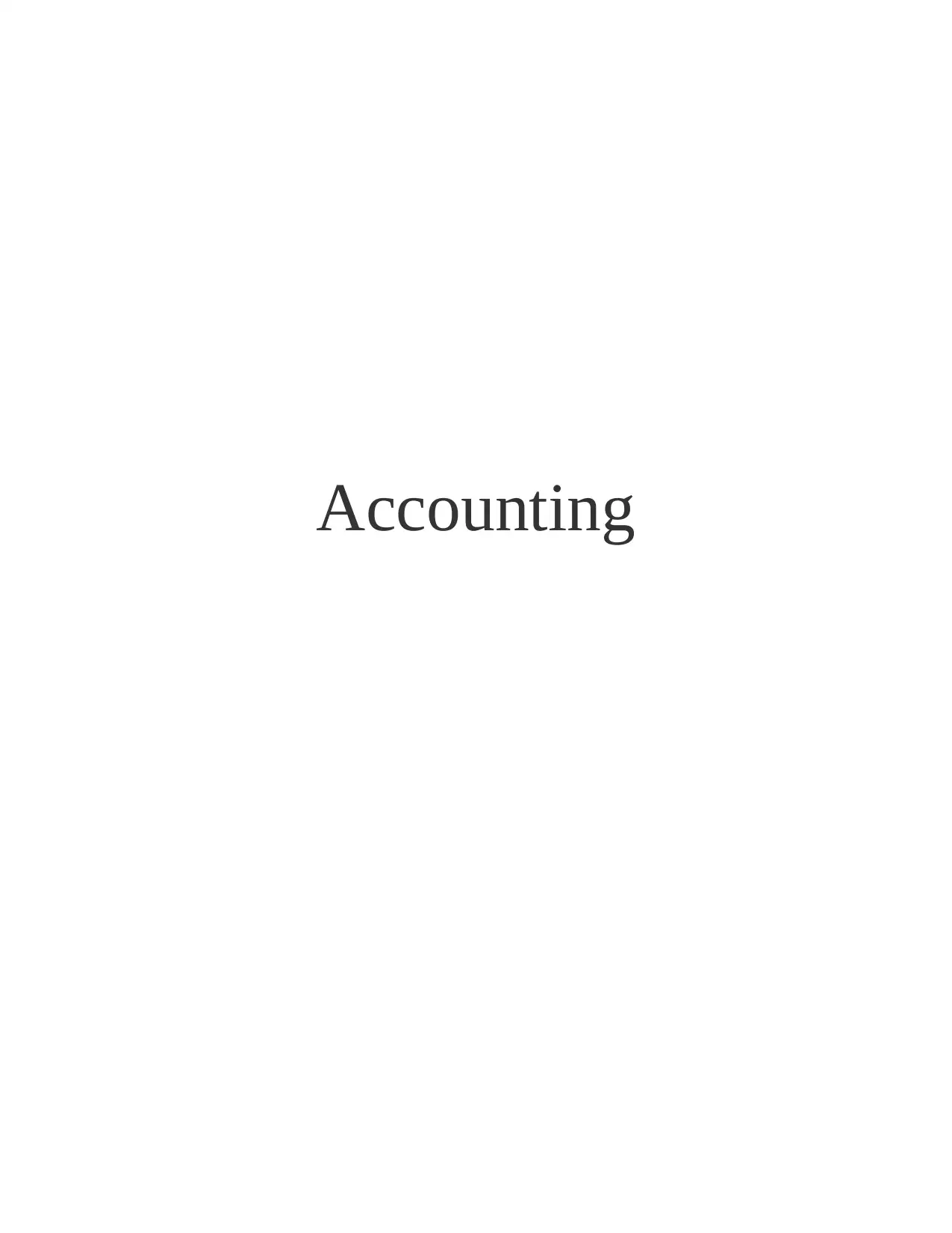
Accounting
Paraphrase This Document
Need a fresh take? Get an instant paraphrase of this document with our AI Paraphraser
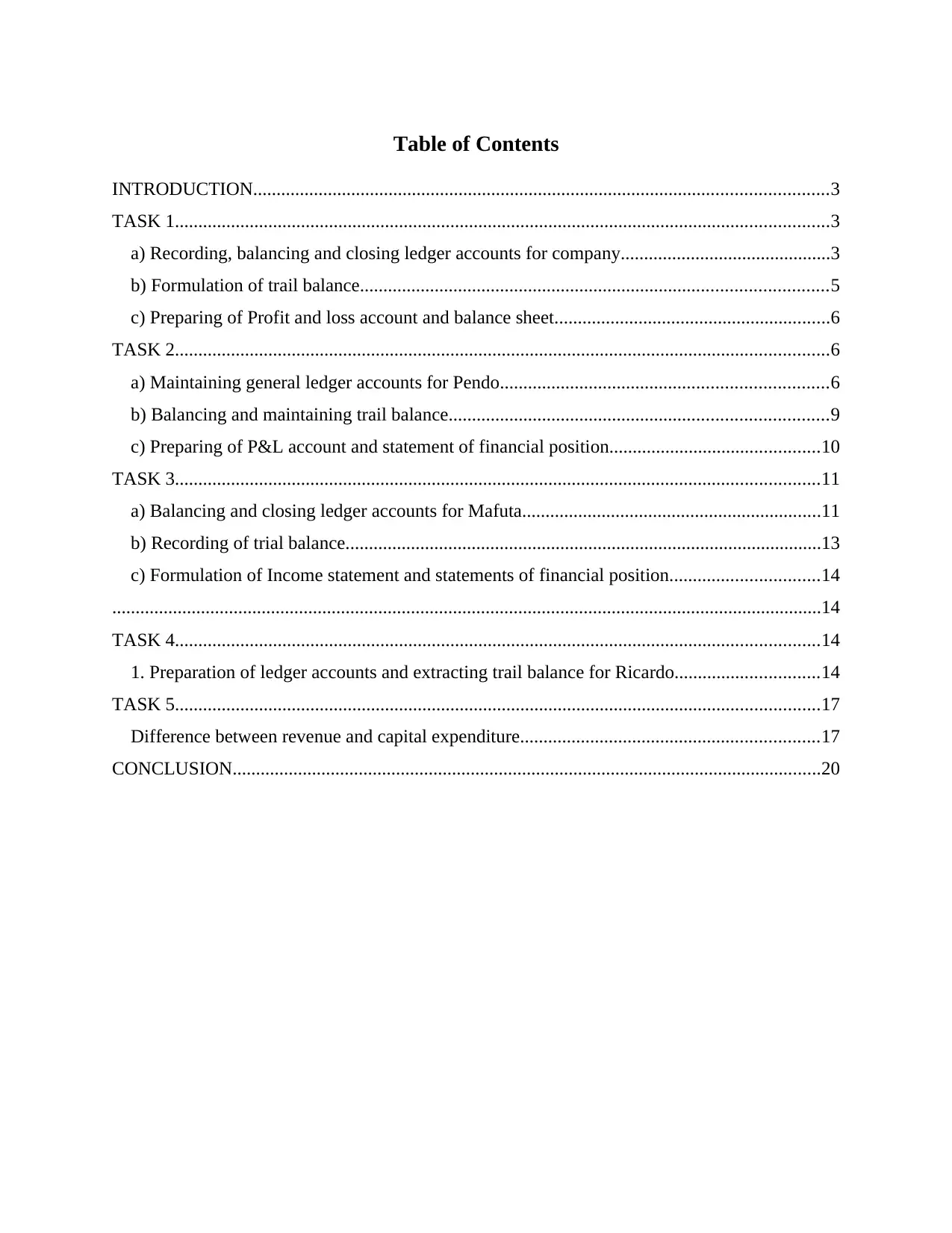
Table of Contents
INTRODUCTION...........................................................................................................................3
TASK 1............................................................................................................................................3
a) Recording, balancing and closing ledger accounts for company.............................................3
b) Formulation of trail balance....................................................................................................5
c) Preparing of Profit and loss account and balance sheet...........................................................6
TASK 2............................................................................................................................................6
a) Maintaining general ledger accounts for Pendo......................................................................6
b) Balancing and maintaining trail balance.................................................................................9
c) Preparing of P&L account and statement of financial position.............................................10
TASK 3..........................................................................................................................................11
a) Balancing and closing ledger accounts for Mafuta................................................................11
b) Recording of trial balance......................................................................................................13
c) Formulation of Income statement and statements of financial position................................14
........................................................................................................................................................14
TASK 4..........................................................................................................................................14
1. Preparation of ledger accounts and extracting trail balance for Ricardo...............................14
TASK 5..........................................................................................................................................17
Difference between revenue and capital expenditure................................................................17
CONCLUSION..............................................................................................................................20
INTRODUCTION...........................................................................................................................3
TASK 1............................................................................................................................................3
a) Recording, balancing and closing ledger accounts for company.............................................3
b) Formulation of trail balance....................................................................................................5
c) Preparing of Profit and loss account and balance sheet...........................................................6
TASK 2............................................................................................................................................6
a) Maintaining general ledger accounts for Pendo......................................................................6
b) Balancing and maintaining trail balance.................................................................................9
c) Preparing of P&L account and statement of financial position.............................................10
TASK 3..........................................................................................................................................11
a) Balancing and closing ledger accounts for Mafuta................................................................11
b) Recording of trial balance......................................................................................................13
c) Formulation of Income statement and statements of financial position................................14
........................................................................................................................................................14
TASK 4..........................................................................................................................................14
1. Preparation of ledger accounts and extracting trail balance for Ricardo...............................14
TASK 5..........................................................................................................................................17
Difference between revenue and capital expenditure................................................................17
CONCLUSION..............................................................................................................................20
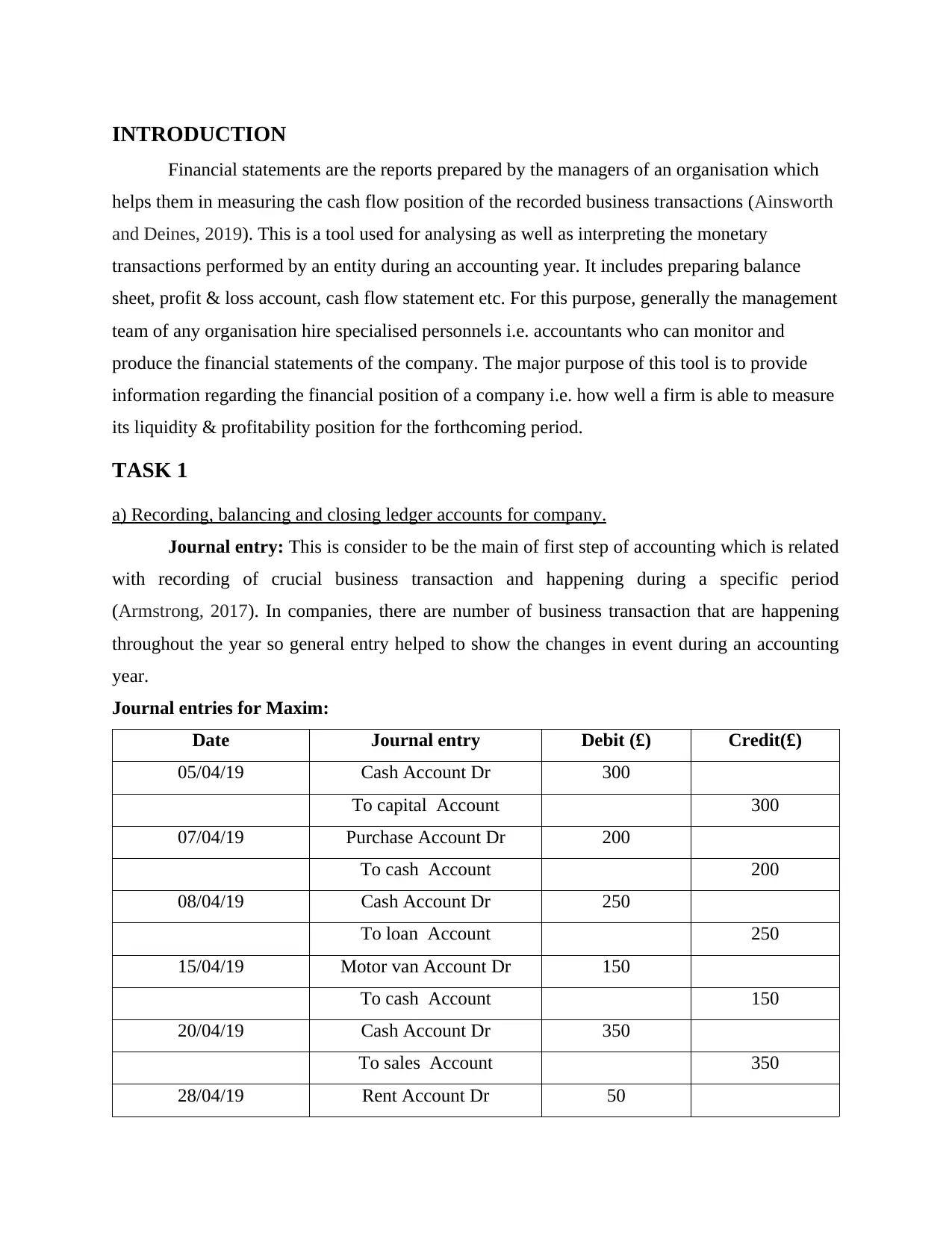
INTRODUCTION
Financial statements are the reports prepared by the managers of an organisation which
helps them in measuring the cash flow position of the recorded business transactions (Ainsworth
and Deines, 2019). This is a tool used for analysing as well as interpreting the monetary
transactions performed by an entity during an accounting year. It includes preparing balance
sheet, profit & loss account, cash flow statement etc. For this purpose, generally the management
team of any organisation hire specialised personnels i.e. accountants who can monitor and
produce the financial statements of the company. The major purpose of this tool is to provide
information regarding the financial position of a company i.e. how well a firm is able to measure
its liquidity & profitability position for the forthcoming period.
TASK 1
a) Recording, balancing and closing ledger accounts for company.
Journal entry: This is consider to be the main of first step of accounting which is related
with recording of crucial business transaction and happening during a specific period
(Armstrong, 2017). In companies, there are number of business transaction that are happening
throughout the year so general entry helped to show the changes in event during an accounting
year.
Journal entries for Maxim:
Date Journal entry Debit (£) Credit(£)
05/04/19 Cash Account Dr 300
To capital Account 300
07/04/19 Purchase Account Dr 200
To cash Account 200
08/04/19 Cash Account Dr 250
To loan Account 250
15/04/19 Motor van Account Dr 150
To cash Account 150
20/04/19 Cash Account Dr 350
To sales Account 350
28/04/19 Rent Account Dr 50
Financial statements are the reports prepared by the managers of an organisation which
helps them in measuring the cash flow position of the recorded business transactions (Ainsworth
and Deines, 2019). This is a tool used for analysing as well as interpreting the monetary
transactions performed by an entity during an accounting year. It includes preparing balance
sheet, profit & loss account, cash flow statement etc. For this purpose, generally the management
team of any organisation hire specialised personnels i.e. accountants who can monitor and
produce the financial statements of the company. The major purpose of this tool is to provide
information regarding the financial position of a company i.e. how well a firm is able to measure
its liquidity & profitability position for the forthcoming period.
TASK 1
a) Recording, balancing and closing ledger accounts for company.
Journal entry: This is consider to be the main of first step of accounting which is related
with recording of crucial business transaction and happening during a specific period
(Armstrong, 2017). In companies, there are number of business transaction that are happening
throughout the year so general entry helped to show the changes in event during an accounting
year.
Journal entries for Maxim:
Date Journal entry Debit (£) Credit(£)
05/04/19 Cash Account Dr 300
To capital Account 300
07/04/19 Purchase Account Dr 200
To cash Account 200
08/04/19 Cash Account Dr 250
To loan Account 250
15/04/19 Motor van Account Dr 150
To cash Account 150
20/04/19 Cash Account Dr 350
To sales Account 350
28/04/19 Rent Account Dr 50
⊘ This is a preview!⊘
Do you want full access?
Subscribe today to unlock all pages.

Trusted by 1+ million students worldwide
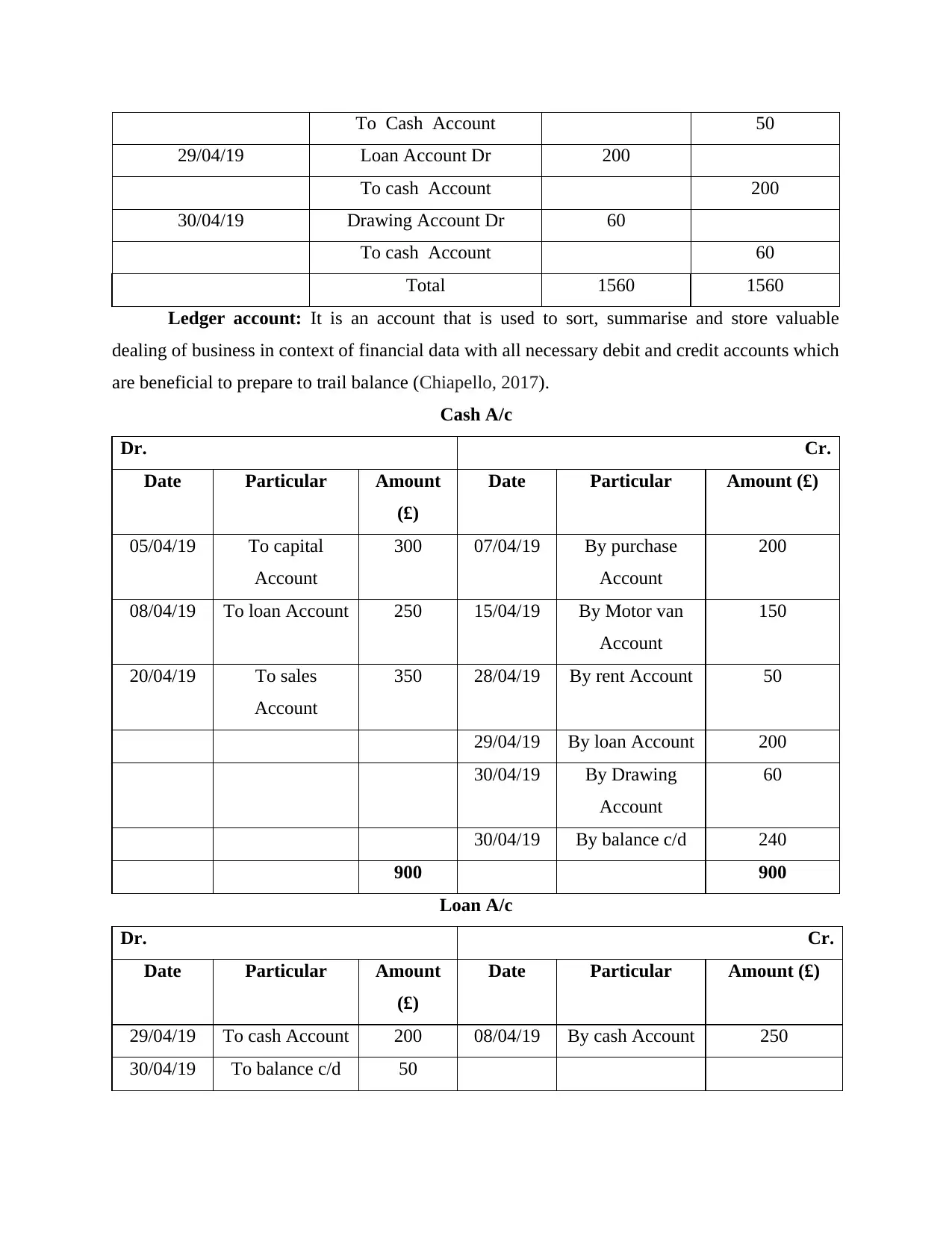
To Cash Account 50
29/04/19 Loan Account Dr 200
To cash Account 200
30/04/19 Drawing Account Dr 60
To cash Account 60
Total 1560 1560
Ledger account: It is an account that is used to sort, summarise and store valuable
dealing of business in context of financial data with all necessary debit and credit accounts which
are beneficial to prepare to trail balance (Chiapello, 2017).
Cash A/c
Dr. Cr.
Date Particular Amount
(£)
Date Particular Amount (£)
05/04/19 To capital
Account
300 07/04/19 By purchase
Account
200
08/04/19 To loan Account 250 15/04/19 By Motor van
Account
150
20/04/19 To sales
Account
350 28/04/19 By rent Account 50
29/04/19 By loan Account 200
30/04/19 By Drawing
Account
60
30/04/19 By balance c/d 240
900 900
Loan A/c
Dr. Cr.
Date Particular Amount
(£)
Date Particular Amount (£)
29/04/19 To cash Account 200 08/04/19 By cash Account 250
30/04/19 To balance c/d 50
29/04/19 Loan Account Dr 200
To cash Account 200
30/04/19 Drawing Account Dr 60
To cash Account 60
Total 1560 1560
Ledger account: It is an account that is used to sort, summarise and store valuable
dealing of business in context of financial data with all necessary debit and credit accounts which
are beneficial to prepare to trail balance (Chiapello, 2017).
Cash A/c
Dr. Cr.
Date Particular Amount
(£)
Date Particular Amount (£)
05/04/19 To capital
Account
300 07/04/19 By purchase
Account
200
08/04/19 To loan Account 250 15/04/19 By Motor van
Account
150
20/04/19 To sales
Account
350 28/04/19 By rent Account 50
29/04/19 By loan Account 200
30/04/19 By Drawing
Account
60
30/04/19 By balance c/d 240
900 900
Loan A/c
Dr. Cr.
Date Particular Amount
(£)
Date Particular Amount (£)
29/04/19 To cash Account 200 08/04/19 By cash Account 250
30/04/19 To balance c/d 50
Paraphrase This Document
Need a fresh take? Get an instant paraphrase of this document with our AI Paraphraser
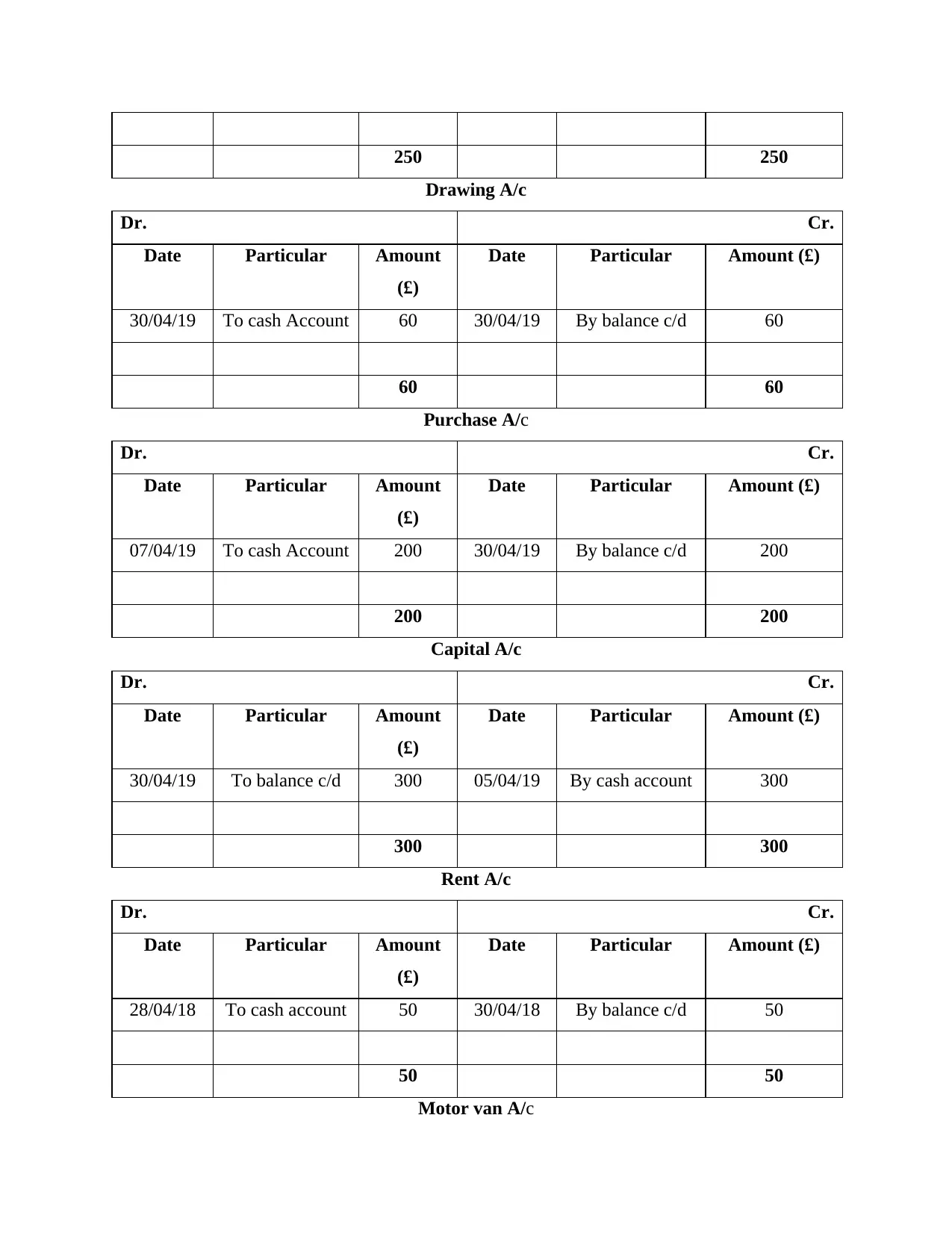
250 250
Drawing A/c
Dr. Cr.
Date Particular Amount
(£)
Date Particular Amount (£)
30/04/19 To cash Account 60 30/04/19 By balance c/d 60
60 60
Purchase A/c
Dr. Cr.
Date Particular Amount
(£)
Date Particular Amount (£)
07/04/19 To cash Account 200 30/04/19 By balance c/d 200
200 200
Capital A/c
Dr. Cr.
Date Particular Amount
(£)
Date Particular Amount (£)
30/04/19 To balance c/d 300 05/04/19 By cash account 300
300 300
Rent A/c
Dr. Cr.
Date Particular Amount
(£)
Date Particular Amount (£)
28/04/18 To cash account 50 30/04/18 By balance c/d 50
50 50
Motor van A/c
Drawing A/c
Dr. Cr.
Date Particular Amount
(£)
Date Particular Amount (£)
30/04/19 To cash Account 60 30/04/19 By balance c/d 60
60 60
Purchase A/c
Dr. Cr.
Date Particular Amount
(£)
Date Particular Amount (£)
07/04/19 To cash Account 200 30/04/19 By balance c/d 200
200 200
Capital A/c
Dr. Cr.
Date Particular Amount
(£)
Date Particular Amount (£)
30/04/19 To balance c/d 300 05/04/19 By cash account 300
300 300
Rent A/c
Dr. Cr.
Date Particular Amount
(£)
Date Particular Amount (£)
28/04/18 To cash account 50 30/04/18 By balance c/d 50
50 50
Motor van A/c
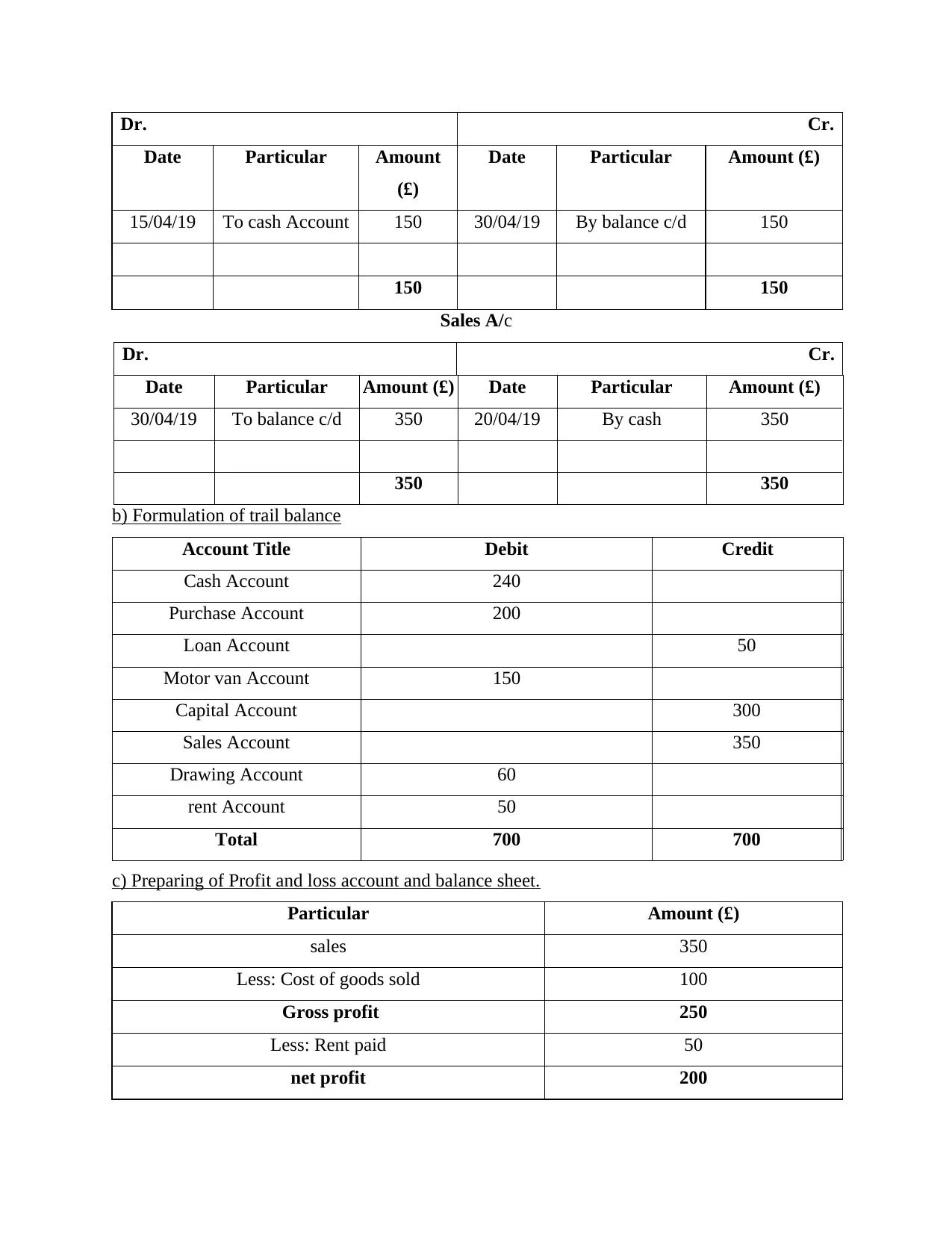
Dr. Cr.
Date Particular Amount
(£)
Date Particular Amount (£)
15/04/19 To cash Account 150 30/04/19 By balance c/d 150
150 150
Sales A/c
Dr. Cr.
Date Particular Amount (£) Date Particular Amount (£)
30/04/19 To balance c/d 350 20/04/19 By cash 350
350 350
b) Formulation of trail balance
Account Title Debit Credit
Cash Account 240
Purchase Account 200
Loan Account 50
Motor van Account 150
Capital Account 300
Sales Account 350
Drawing Account 60
rent Account 50
Total 700 700
c) Preparing of Profit and loss account and balance sheet.
Particular Amount (£)
sales 350
Less: Cost of goods sold 100
Gross profit 250
Less: Rent paid 50
net profit 200
Date Particular Amount
(£)
Date Particular Amount (£)
15/04/19 To cash Account 150 30/04/19 By balance c/d 150
150 150
Sales A/c
Dr. Cr.
Date Particular Amount (£) Date Particular Amount (£)
30/04/19 To balance c/d 350 20/04/19 By cash 350
350 350
b) Formulation of trail balance
Account Title Debit Credit
Cash Account 240
Purchase Account 200
Loan Account 50
Motor van Account 150
Capital Account 300
Sales Account 350
Drawing Account 60
rent Account 50
Total 700 700
c) Preparing of Profit and loss account and balance sheet.
Particular Amount (£)
sales 350
Less: Cost of goods sold 100
Gross profit 250
Less: Rent paid 50
net profit 200
⊘ This is a preview!⊘
Do you want full access?
Subscribe today to unlock all pages.

Trusted by 1+ million students worldwide
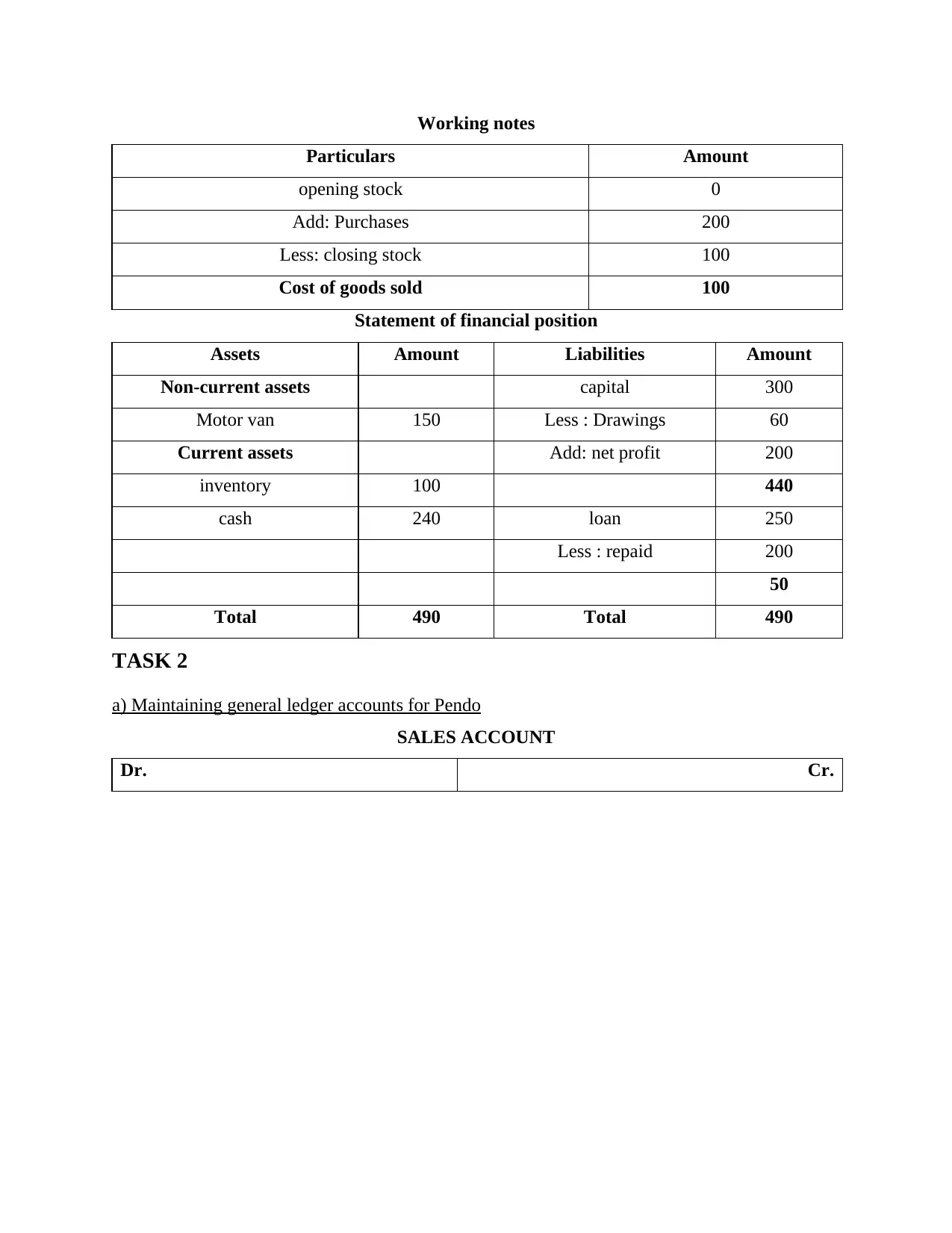
Working notes
Particulars Amount
opening stock 0
Add: Purchases 200
Less: closing stock 100
Cost of goods sold 100
Statement of financial position
Assets Amount Liabilities Amount
Non-current assets capital 300
Motor van 150 Less : Drawings 60
Current assets Add: net profit 200
inventory 100 440
cash 240 loan 250
Less : repaid 200
50
Total 490 Total 490
TASK 2
a) Maintaining general ledger accounts for Pendo
SALES ACCOUNT
Dr. Cr.
Particulars Amount
opening stock 0
Add: Purchases 200
Less: closing stock 100
Cost of goods sold 100
Statement of financial position
Assets Amount Liabilities Amount
Non-current assets capital 300
Motor van 150 Less : Drawings 60
Current assets Add: net profit 200
inventory 100 440
cash 240 loan 250
Less : repaid 200
50
Total 490 Total 490
TASK 2
a) Maintaining general ledger accounts for Pendo
SALES ACCOUNT
Dr. Cr.
Paraphrase This Document
Need a fresh take? Get an instant paraphrase of this document with our AI Paraphraser
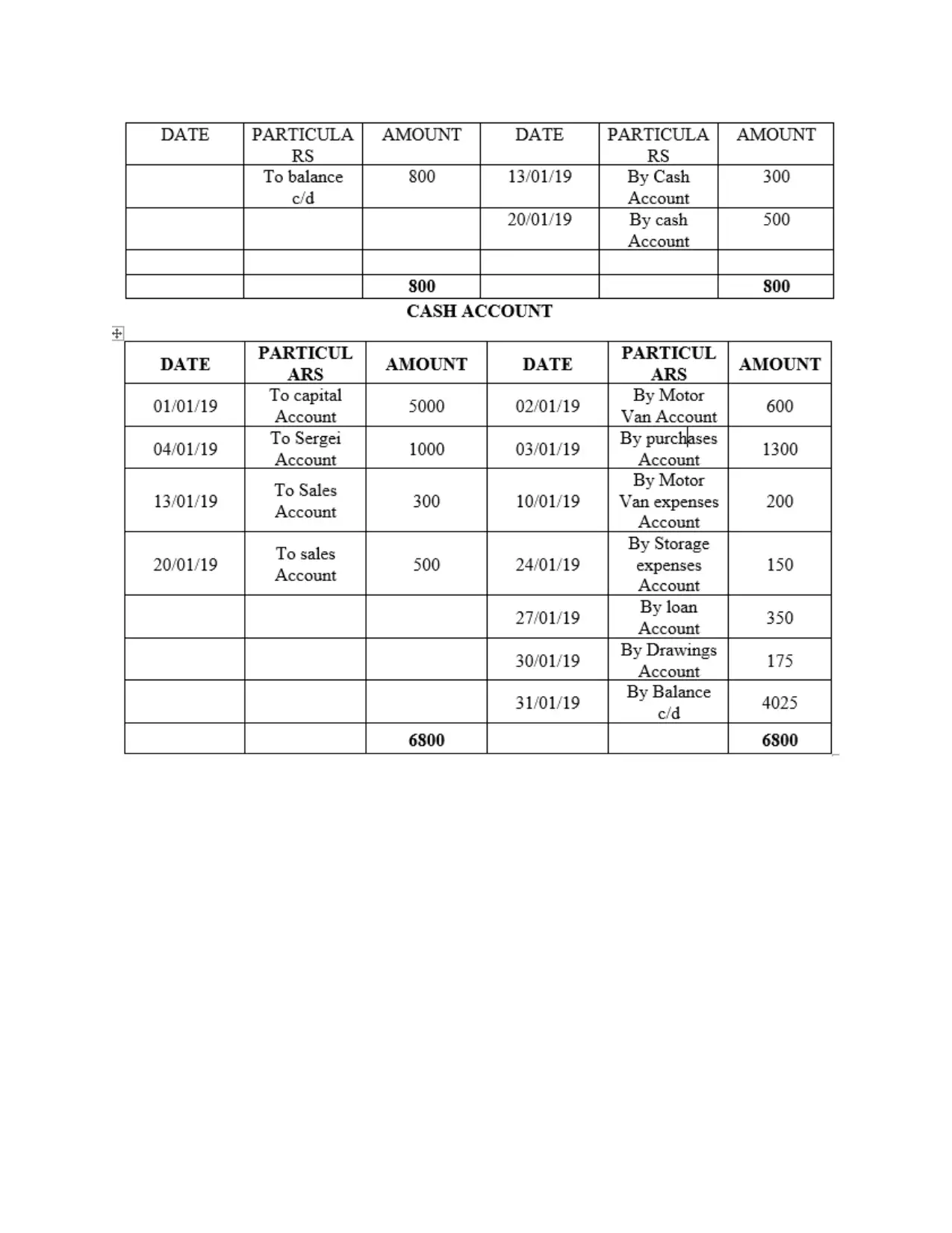
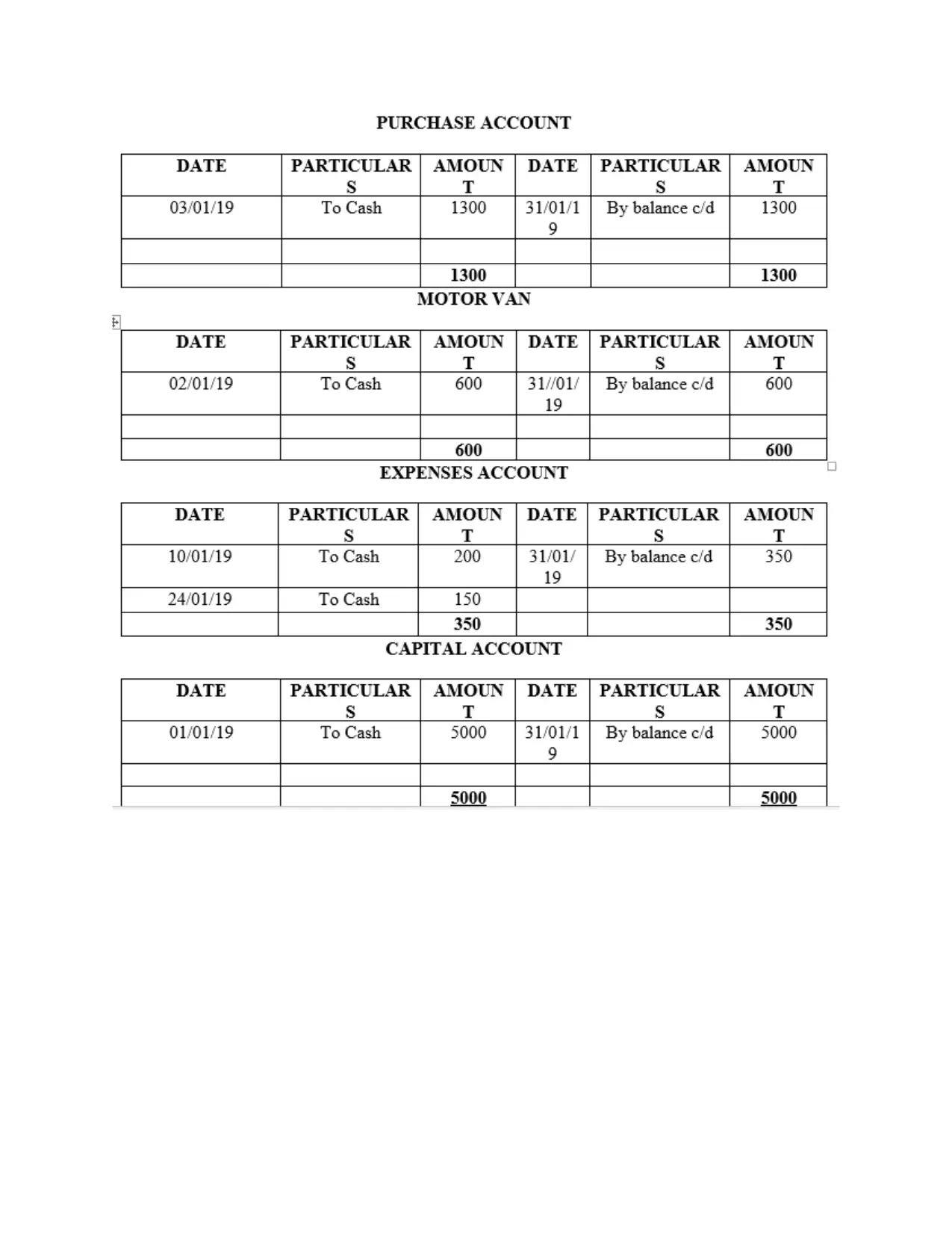
⊘ This is a preview!⊘
Do you want full access?
Subscribe today to unlock all pages.

Trusted by 1+ million students worldwide
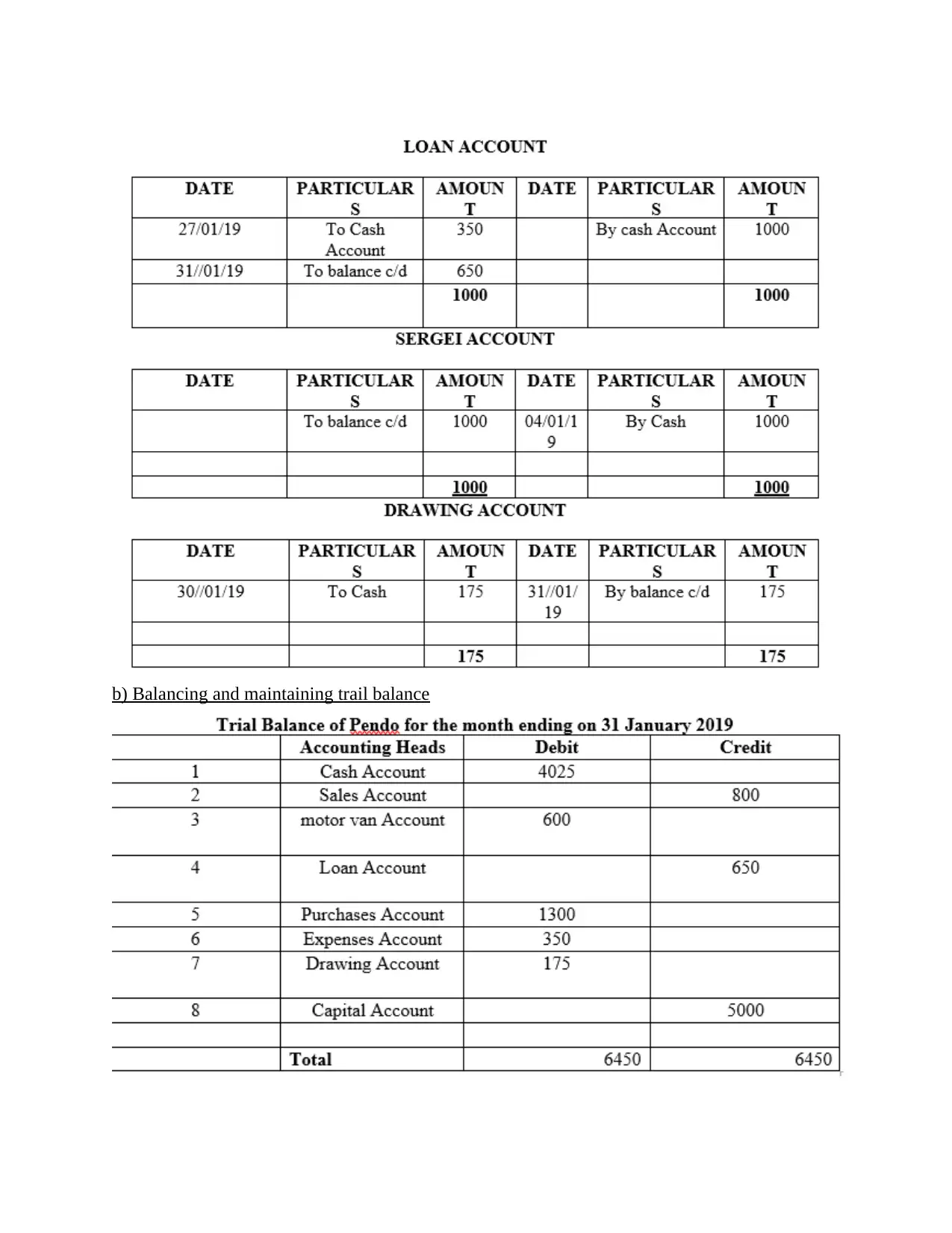
b) Balancing and maintaining trail balance
Paraphrase This Document
Need a fresh take? Get an instant paraphrase of this document with our AI Paraphraser
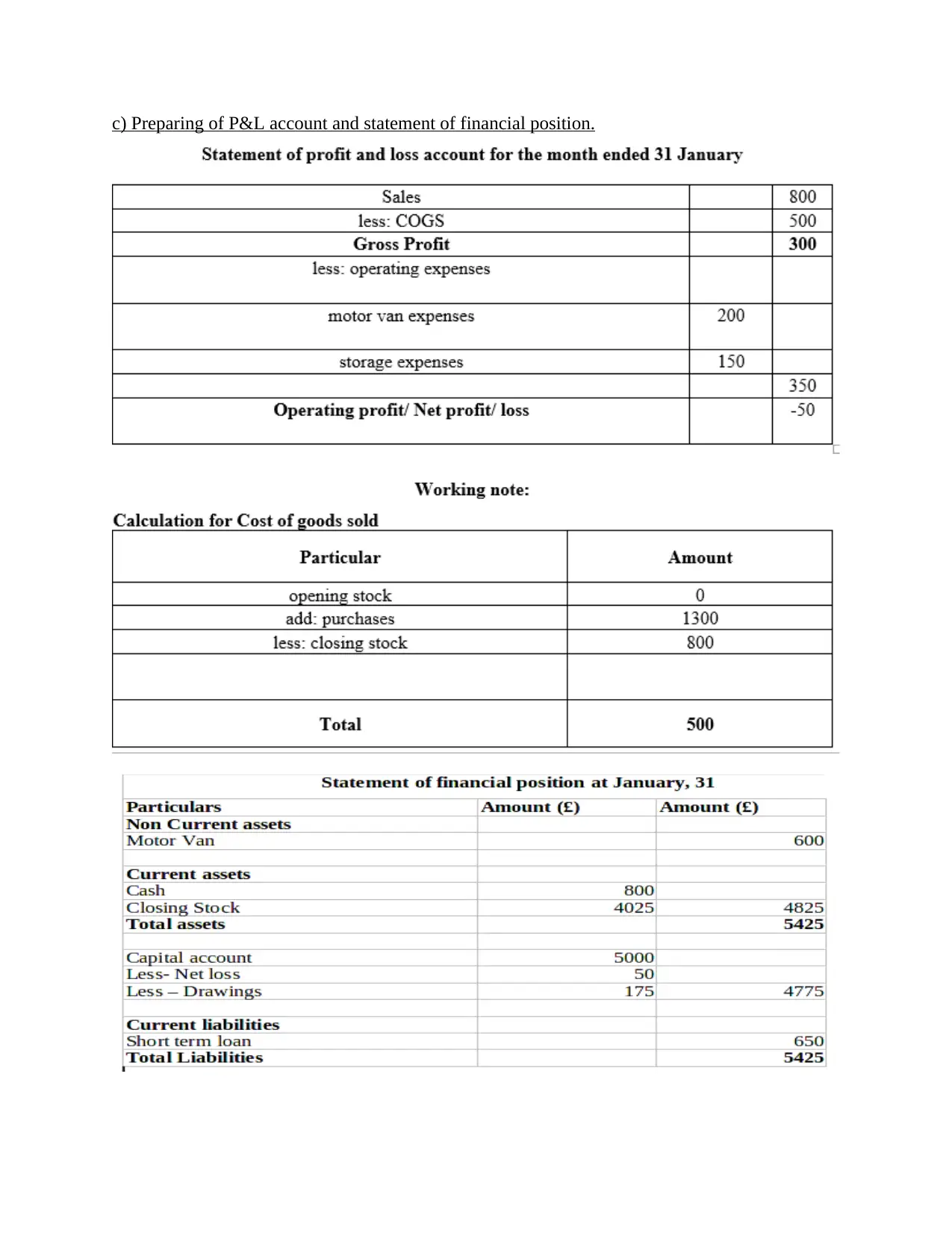
c) Preparing of P&L account and statement of financial position.

TASK 3
a) Balancing and closing ledger accounts for Mafuta
Cash A/c
Dr. Cr.
Date Particular Amount
(£)
Date Particular Amount
(£)
01/01/19 To balance B/d 343 05/01/19 By wages
Account
12
07/01/19 To smith Account 18 09/01/19 By Max Account 21
11/01/19 To sales Account 64 14/01/19 By wages
Account
14
21/01/19 To sales Account 110 15/01/19 By Rich Account 162
23/01/19 To Harvey
Account
25 20/01/19 By office desk
Account
32
28/01/19 To sales Account 84 21/01/19 By wages 17
a) Balancing and closing ledger accounts for Mafuta
Cash A/c
Dr. Cr.
Date Particular Amount
(£)
Date Particular Amount
(£)
01/01/19 To balance B/d 343 05/01/19 By wages
Account
12
07/01/19 To smith Account 18 09/01/19 By Max Account 21
11/01/19 To sales Account 64 14/01/19 By wages
Account
14
21/01/19 To sales Account 110 15/01/19 By Rich Account 162
23/01/19 To Harvey
Account
25 20/01/19 By office desk
Account
32
28/01/19 To sales Account 84 21/01/19 By wages 17
⊘ This is a preview!⊘
Do you want full access?
Subscribe today to unlock all pages.

Trusted by 1+ million students worldwide
1 out of 21
Related Documents
Your All-in-One AI-Powered Toolkit for Academic Success.
+13062052269
info@desklib.com
Available 24*7 on WhatsApp / Email
![[object Object]](/_next/static/media/star-bottom.7253800d.svg)
Unlock your academic potential
Copyright © 2020–2025 A2Z Services. All Rights Reserved. Developed and managed by ZUCOL.





